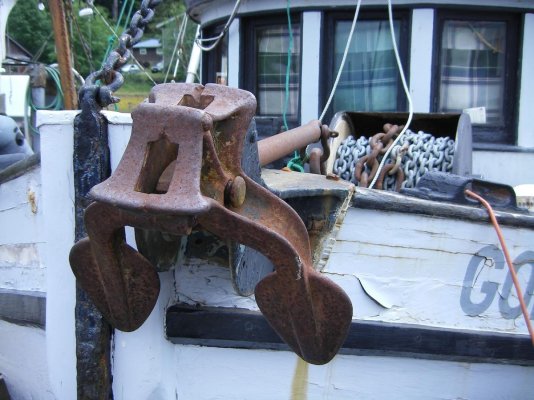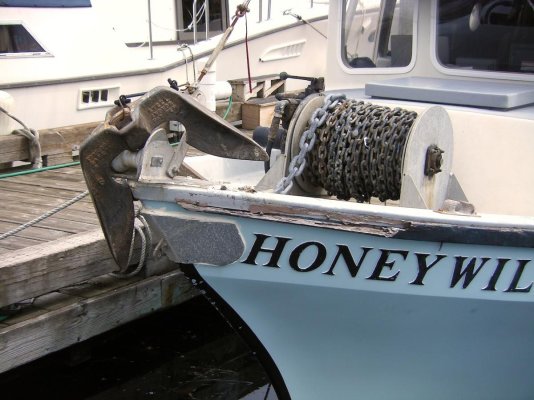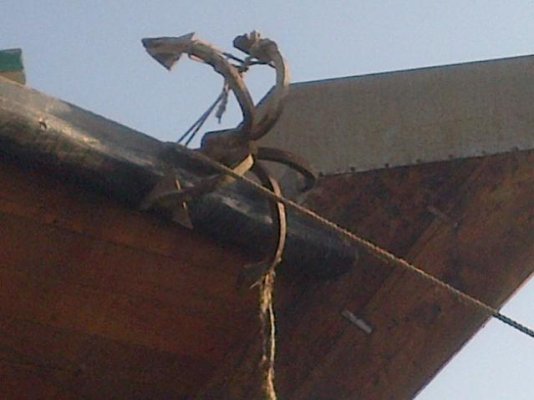big is better
Hi All.
Rex from Anchor Right Australia.
Doesn’t matter whether the anchor you are deploying is a Noah’s Ark job or the latest fandangle new design bigger will always be better, heavier anchors with blunt bulky toes will always work better than the smaller ones of the same brand with the same blunt toes.
Sharpen them and you will find an instant improvement on those anchors to set and penetrate. Bigger means more weight concentrated on the business end of your anchor, for instance, if you stand, present the normal weight of a garden spade to your lawn it will not penetrate, what happens when you stand on it.
So yes in areas that are hard to penetrate a heavier bigger anchor will have a better chance to set.
A much lighter modern anchor design will in most cases outperform many of the older designs simply because they penetrate so much better in a wider variety of substrates, this has been the WOW hype factor on new anchor technology, beware, this wow factor doesn’t mean to say all new designs will produce more holding power, any anchor design once buried is where all your holding power comes from, a well buried CQR is hard to beat and will normally be sufficient as long as you have the right size for the boat.
If you are anchoring overnight on slab rock you will have no trustworthy holding power regardless of anchor size and design. Heavier in this situation will simply mean you will fight resistance longer before you drag.
(Change of tide and the ability to reset in a shorter distance)
These are two of the largest improvements in modern anchor technology in many designs, the next line may upset some but it is not with malice but how it is, concave design with a hoop, don’t get to settled with this design in change of tide or wind shift ,although the elements can break any anchor design out, as Delfin said, mud and weed will build up and compress between the hoop and the fluke, this can give this design a shallow set, whilst this may or may not be a problem, it can ,does, make it very difficult for the anchor to reset should it break out, this was our very first patented design, we never produced it and redesigned to convex so we do have the knowledge.
Do your own research, the best facts to back this up are you, and a few years on the market with forums like these uncover the facts with a design. Believe me those facts are out there and from what I’ve seen you guys are onto it.
There have been many questions in relation to, if I go up a size will my winch handle it, in most cases yes but again depending on design you may be pulling up a load of mud, this mud may weigh four times more than the anchor. If you choose a concave design it is important you take this into account, this anchor has surfaced; imagine the volume when first broken out.
Sorry guys Icannot seem to load this picture.
Holding power
I am not talking how much Rhode, scope, snubbers these can all be an advantage, I am talking an anchors design, ( width versus depth) if an anchor design such as CQR or similar will penetrate 2 inches deeper than another design that relies on volume, then the broader anchor that sets shallower will to be at least four inches broader than a CQR or similar design to produce the same holding power.
So if you go for a broader anchor design check out the penetration depth ability, don’t be sold on the slogan (the widest fluke area of any anchor for improved holding) if it proves to bury deep you have the best of both worlds, depth can be more advantageous than width in most situations.eg weed, or weed and mud.
Of course how much scope, type of scope you put out will improve or reduce the holding power of all anchor designs, if you are ever caught in a situation that you would rather not be in then do not defy the actual physics, three to one for light anchoring, five to seven to one for overnight, everything you’ve got if needs be, the more you let out depending on design the deeper your anchor will go, the more rope or chain will also reduce impact and less chance of dislodgment, if you don’t agree then research what I say or somewhere down that track you will pay the price.
So what to look for in new anchor technology, a design that will penetrate deep in many types of ocean floor terrain, make sure the anchor is certified or at least meets simple standards, ask to see these test certs, are they legitimate, what type of steels are they made of, forget about glossy magazine tests, research designs, the company producing them and what your forums say.
Worth researching, design is a good place to start, look for a fluke design that has an excellent entry point followed by a fluke that doesn’t plough but allows movement of substrate whilst compressing, this encourages the anchor to dive, how does it respond in a wind shift or change of tide, a deep throat opening will always be an advantage in weed, other factors that are of importance to many, will it fit my arrangement and oddly how good it looks. It is not possible to have the perfect anchor, it will never exist, they are all a compromise, still heavier is better.
Best comment from rwidman
As for "the major consideration in anchoring safely", technique is up there with size. If you just drop the anchor off the bow, cut the engine, and go below to fix a drink, size isn't going to be that much help. Learn how to set an anchor correctly and you'll be ahead of the game.
__________________
The only thing I would add to that is if you cannot set your anchor after trying several areas then get rid of it and buy one that will.
Now I know many of you have many specialized professions from building air craft to saving lives but each to his own profession, I ain’t no Guru either but I have been designing testing anchors for the commercial pleasure boat and trailer boat industry now for the last twenty years so have some knowledge.
Some may appreciate my comments and obviously I will give some a heache,Just had to throw in my two bobs worth.
Regards to all, CEO of Anchor Right Australia.
Rex.
Hi All.
Rex from Anchor Right Australia.
Doesn’t matter whether the anchor you are deploying is a Noah’s Ark job or the latest fandangle new design bigger will always be better, heavier anchors with blunt bulky toes will always work better than the smaller ones of the same brand with the same blunt toes.
Sharpen them and you will find an instant improvement on those anchors to set and penetrate. Bigger means more weight concentrated on the business end of your anchor, for instance, if you stand, present the normal weight of a garden spade to your lawn it will not penetrate, what happens when you stand on it.
So yes in areas that are hard to penetrate a heavier bigger anchor will have a better chance to set.
A much lighter modern anchor design will in most cases outperform many of the older designs simply because they penetrate so much better in a wider variety of substrates, this has been the WOW hype factor on new anchor technology, beware, this wow factor doesn’t mean to say all new designs will produce more holding power, any anchor design once buried is where all your holding power comes from, a well buried CQR is hard to beat and will normally be sufficient as long as you have the right size for the boat.
If you are anchoring overnight on slab rock you will have no trustworthy holding power regardless of anchor size and design. Heavier in this situation will simply mean you will fight resistance longer before you drag.
(Change of tide and the ability to reset in a shorter distance)
These are two of the largest improvements in modern anchor technology in many designs, the next line may upset some but it is not with malice but how it is, concave design with a hoop, don’t get to settled with this design in change of tide or wind shift ,although the elements can break any anchor design out, as Delfin said, mud and weed will build up and compress between the hoop and the fluke, this can give this design a shallow set, whilst this may or may not be a problem, it can ,does, make it very difficult for the anchor to reset should it break out, this was our very first patented design, we never produced it and redesigned to convex so we do have the knowledge.
Do your own research, the best facts to back this up are you, and a few years on the market with forums like these uncover the facts with a design. Believe me those facts are out there and from what I’ve seen you guys are onto it.
There have been many questions in relation to, if I go up a size will my winch handle it, in most cases yes but again depending on design you may be pulling up a load of mud, this mud may weigh four times more than the anchor. If you choose a concave design it is important you take this into account, this anchor has surfaced; imagine the volume when first broken out.
Sorry guys Icannot seem to load this picture.
Holding power
I am not talking how much Rhode, scope, snubbers these can all be an advantage, I am talking an anchors design, ( width versus depth) if an anchor design such as CQR or similar will penetrate 2 inches deeper than another design that relies on volume, then the broader anchor that sets shallower will to be at least four inches broader than a CQR or similar design to produce the same holding power.
So if you go for a broader anchor design check out the penetration depth ability, don’t be sold on the slogan (the widest fluke area of any anchor for improved holding) if it proves to bury deep you have the best of both worlds, depth can be more advantageous than width in most situations.eg weed, or weed and mud.
Of course how much scope, type of scope you put out will improve or reduce the holding power of all anchor designs, if you are ever caught in a situation that you would rather not be in then do not defy the actual physics, three to one for light anchoring, five to seven to one for overnight, everything you’ve got if needs be, the more you let out depending on design the deeper your anchor will go, the more rope or chain will also reduce impact and less chance of dislodgment, if you don’t agree then research what I say or somewhere down that track you will pay the price.
So what to look for in new anchor technology, a design that will penetrate deep in many types of ocean floor terrain, make sure the anchor is certified or at least meets simple standards, ask to see these test certs, are they legitimate, what type of steels are they made of, forget about glossy magazine tests, research designs, the company producing them and what your forums say.
Worth researching, design is a good place to start, look for a fluke design that has an excellent entry point followed by a fluke that doesn’t plough but allows movement of substrate whilst compressing, this encourages the anchor to dive, how does it respond in a wind shift or change of tide, a deep throat opening will always be an advantage in weed, other factors that are of importance to many, will it fit my arrangement and oddly how good it looks. It is not possible to have the perfect anchor, it will never exist, they are all a compromise, still heavier is better.
Best comment from rwidman
As for "the major consideration in anchoring safely", technique is up there with size. If you just drop the anchor off the bow, cut the engine, and go below to fix a drink, size isn't going to be that much help. Learn how to set an anchor correctly and you'll be ahead of the game.
__________________
The only thing I would add to that is if you cannot set your anchor after trying several areas then get rid of it and buy one that will.
Now I know many of you have many specialized professions from building air craft to saving lives but each to his own profession, I ain’t no Guru either but I have been designing testing anchors for the commercial pleasure boat and trailer boat industry now for the last twenty years so have some knowledge.
Some may appreciate my comments and obviously I will give some a heache,Just had to throw in my two bobs worth.
Regards to all, CEO of Anchor Right Australia.
Rex.
Last edited:




